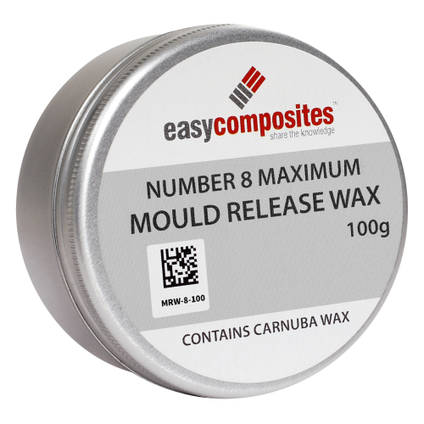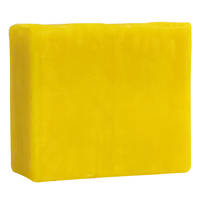Need any help or advice?+44 (0)1782 454499
Downloads (1)
| Safety Datasheet (SDS) |
Specification
General Properties
| Gross Weight | 0.12 | kg |
|---|
Shipping Information
Restrictions
This product is not classed as dangerous goods for transport and can be shipped to all destinations without restriction.
Shipping to EU countries is now done through our European subsidiary based in the Netherlands. All EU customers should use www.easycomposites.eu.
Package Size
There are no package size restrictions or surcharges for this product.
Delivery Cost
To find the delivery cost of this item to your address, add it to your basket and then use the instant shipping calculator on the basket page.
Miracle Gloss Mould Release Wax
- MRW-8-100
- No reviews
Mould release wax is a traditional and still very commonly used release agent in composites moulding and Miracle Gloss (formerly Meguiar's M-08) is one of the most trusted release waxes in the industry.
Apply to the surface of a mould using a rag, buff off and repeat to build up a glossy, reliable release barrier. Suitable for room temperature use with polyester, vinylester and epoxy resins.
Available to buy online in a handy 100g tin or regular 310g tin.
PRODUCT VERSIONS
Pack Size
AVAILABILITY:More than 10 availablefor immediate shipping
We won’t be beaten on price!
If you believe you’re buying an equivalent product cheaper elsewhere, contact us to discuss your requirements.
Mould release wax is the most traditional and still commonly used release agent in composites.
Easy Composites' Number 8 Mould Release Wax is chosen because of it's excellent release properties, easy application and exceptional mirror finish shine.
This handy 100g tin should provide hundreds of releases from small to medium sized moulds.
Typical Uses
Number 8 Mould Release Wax can be used on its own to provide a reliable mould release surface when making composites using polyester, vinyl ester and epoxy resin systems although it is not suitable for high temperature applications such as elevated temperature cure, pre-preg or wet-lay where exotherm in the part is likely to take the mould surface over 50°C.
Further Information
Application
Ensure the mould surface is properly sealed (porous mould surfaces such as wood or plaster must be sealed prior to the application of any mould release agent) clean and free of contaminants.
Using a clean, lint-free cloth collect a small amount of wax on the cloth (like you would shoe polish) and then begin to apply to the surface of your mould in small circular motions. Ensure you cover the entire mould surface, paying particular attention to any tight corners.
Allow the wax to dry which will cause its appearance to 'matt off' slightly making the swirls more apparent on the mould surface. This will take around 15mins.
Using a different, clean, lint-free cloth start to gently skim the cloth over the surface of the mould. This will start to gently smooth out the swirl pattern of the wax. Always keep you pressure very light, you want to polish the wax, not remove it from the mould's surface. Once the surface of the mould looks completely swirl free and shiny you should repeat the application of the wax about 3 more times, each time following the same procedure as above.
Mould release wax is the most traditional and still commonly used release agent in composites.
Easy Composites' Number 8 Mould Release Wax is chosen because of it's excellent release properties, easy application and exceptional mirror finish shine.
This handy 100g tin should provide hundreds of releases from small to medium sized moulds.
Typical Uses
Number 8 Mould Release Wax can be used on its own to provide a reliable mould release surface when making composites using polyester, vinyl ester and epoxy resin systems although it is not suitable for high temperature applications such as elevated temperature cure, pre-preg or wet-lay where exotherm in the part is likely to take the mould surface over 50°C.
Further Information
Application
Ensure the mould surface is properly sealed (porous mould surfaces such as wood or plaster must be sealed prior to the application of any mould release agent) clean and free of contaminants.
Using a clean, lint-free cloth collect a small amount of wax on the cloth (like you would shoe polish) and then begin to apply to the surface of your mould in small circular motions. Ensure you cover the entire mould surface, paying particular attention to any tight corners.
Allow the wax to dry which will cause its appearance to 'matt off' slightly making the swirls more apparent on the mould surface. This will take around 15mins.
Using a different, clean, lint-free cloth start to gently skim the cloth over the surface of the mould. This will start to gently smooth out the swirl pattern of the wax. Always keep you pressure very light, you want to polish the wax, not remove it from the mould's surface. Once the surface of the mould looks completely swirl free and shiny you should repeat the application of the wax about 3 more times, each time following the same procedure as above.
Downloads (1)
| Safety Datasheet (SDS) |
Specification
General Properties
| Gross Weight | 0.12 | kg |
|---|
If you are in any doubt it's always best to be on the safe-side and apply an extra coat!
The wax has a maximum service temperature of 50°C which makes it unsuitable for high temperature applications such as curing pre-Pregs.
I guess this really depends on just how rough the surface of the aluminium is. If we're talking of lots of light scratches over the whole surface then it's very likely that mould release wax, such as the Miracle Gloss, would be sufficient to fill in the scratches on the surface of the part and ensure the mould releases without any difficulty. The more coats of wax you apply, the more likely this is to be the case.
However, if the scratches are really coarse, resulting in some of the aluminium almost sticking up from the surface then this would be more that the wax could infill and is likely to cause the mould to mechanically grip and lock onto this surface. If this is the case then no release agent is going to work reliably and instead you would need to improve the surface of the component (using abrasive paper and wire wool) until it's smooth enough and free of anything that the mould could grip onto. If you took the surface to an 800 grit abrasive paper then there wouldn't be any concerns.
Either way, mould release wax is a good release agent choice when you want to fill in some micro-texture in the surface of an original part or pattern. PVA is another good option, particularly if you were able to spray it so that you can build up more than one layer (more than one layer by wipe application of PVA isn't possible).
Yes, do people sometimes do this. If you're going to try then the sequence is wax then PVA, however, what you're likely to find is that the PVA 'fish-eyes' away from the wax so much that it's almost impossible to get any kind of a coating of PVA onto a waxed surface. You normally just end up with a few patches of PVA in some corners and then streaks/beads of it in lines where the wax has repelled it. If this doesn't happen then that's usually a good indication that you didn't do a very good job of applying the wax!
Providing you're using suitable materials for your patterns and/or moulds then it shouldn't ever be necessary to use both wax and PVA, just one (most often wax) applied correctly, will be sufficient.
Yes, providing your mould surface is suitable (non-porous) you can could use the Mould Release Wax to prevent resin from sticking to your mould surface.
The wax is not suitable as a release agent on silicone. A simple good release agent for silicone to silicone is petroleum jelly brushed on in a thin layer.
ASK YOUR OWN QUESTION
Customer Product Reviews for Miracle Gloss Mould Release Wax
SUBMIT YOUR OWN PRODUCT REVIEW
We publish all reviews for verified purchases. Submit your own review and help other customers with their choices.SUBMIT YOUR OWN PRODUCT REVIEW
We publish all reviews for verified purchases. Submit your own review and help other customers with their choices.Shipping Information
Restrictions
This product is not classed as dangerous goods for transport and can be shipped to all destinations without restriction.
Shipping to EU countries is now done through our European subsidiary based in the Netherlands. All EU customers should use www.easycomposites.eu.
Package Size
There are no package size restrictions or surcharges for this product.
Delivery Cost
To find the delivery cost of this item to your address, add it to your basket and then use the instant shipping calculator on the basket page.
CUSTOMERS ALSO PURCHASED
CUSTOMERS ALSO PURCHASED
100% SECURE
PAYMENT METHODS


Easy Composites Ltd, registered in England 7486797. All content copyright (C) Easy Composites Ltd, 2025. All rights reserved.


